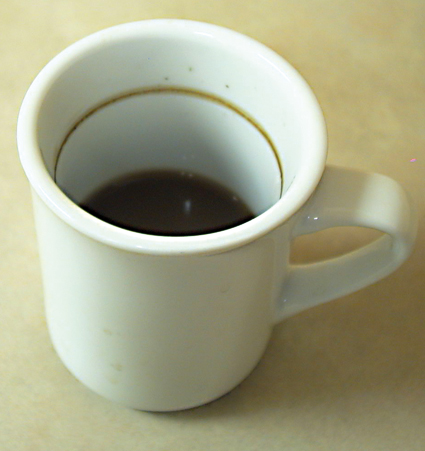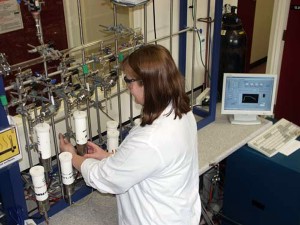Excuse me. Your bias is showing!

The scientific world received some shocking news last year. Researchers Jere Jenkins and Ephraim Fischbach of Purdue University, and Peter Sturrock of Stanford published an article that seems to challenge the “clock” used to approximate the age of archaeological objects. If this study is accurate, it calls into question the notion of a constant radioactive decay rate by which scientists gauge the ages of fossils when publishing articles from an evolutionary viewpoint.
Other scientists responded with skepticism, attacking some of the procedures used in the study and the conclusions offered about the cause of the apparent decay rate change. Jenkins and Fischbach responded by defending their work.
What do we make of this? Is radiometric dating a reliable clock? Why does it matter?
For example
Imagine you are a scientist who frequents the same bank. You notice a coffee cup always left on the corner of a counter. Your scientific curiosity is piqued as you wonder how long the cup has been there. To tackle the question you use the powers of your scientific mind and method and invite a colleague to join your exploration.
You both observe the cup is one-quarter full; there is a dark film running down the inside from near the top to the current level; it is also slightly warm.
 Your colleague believes the cup has been there for quite some time. He measures the distance from the top of the dark film to the current level. Using the evaporation rate of coffee, he determines the cup has sat there for 26 days.
Your colleague believes the cup has been there for quite some time. He measures the distance from the top of the dark film to the current level. Using the evaporation rate of coffee, he determines the cup has sat there for 26 days.
You question him about the warmth of the cup, which would seem to indicate a much shorter time. He responds noting skylights in the ceiling and the sunlight shining through them today which warmed the cup slightly.
Now you conduct your own research.
You believe the cup has been there less than a day; the warmth of the cup comes from recent use; and the dark film is there because the cup is washed rarely. You measure the temperature of a freshly poured cup of coffee, slowly sip it down to about the one-quarter level and then measure how long it takes for it to cool to the same temperature as the cup in question. Your results suggest the coffee cup has been there for about one hour.
Your colleague’s results are 624 times longer than yours. That’s quite a difference in the clocks!
Starting points
What made such a difference were two important factors? Initial bias (paradigm) and assumptions.
Your friend’s bias was that the cup had been there a long time. The assumptions were: the cup was initially full when left there; the evaporation rate remained constant; and no one poured in or sipped out any coffee while the cup sat there.
Your bias was that the cup had only been there a short time. Your assumptions were: the cup was filled initially; sipped until its current level; and cooled in a normal fashion with no external or artificial cooling or heating.
What assumptions are reasonable to make?
Bias is not a bad thing; everyone has a bias. The question is (to quote Answers in Genesis founder Ken Ham), “Which bias is the best bias to be biased with?” Making assumptions is not bad either. When trying to deal with events in the past, you need assumptions unless you can find information from someone who was there and witnessed the event from start to finish. The questions is, “What assumptions are reasonable to make?”
When trying to date rocks (which, in turn, are used to determine the age of a fossil found in those rocks) different scientists interpret the same data with their own bias and assumptions. Some scientists begin with the bias that the fossil is millions of years old (and thus, so is the rock around it) and the assumption that radiometric dating is a valid and accurate tool for determining age.
Other scientists begin with a bias that most fossils result from the global cataclysmic flood described in Genesis and thus the fossils and rocks around them are, at most, a few thousand years old. They see inherent flaws and enormous assumptions in radiometric dating methods and instead see many other scientific evidences and methods pointing to a world that is much younger. (See references below on the age of the earth and for radiometric dating failures).
Radiometric dating works basically like this: The age of a substance is calculated by measuring the current ratio of radioactive to non-radioactive material in a given sample and applying a determined, constant decay rate.
This method has at least four major assumptions (similar to the coffee cup example):
1) the initial amount of both radioactive and non-radioactive materials is determined with an educated guess;
2) the rate of decay from radioactive to non-radioactive material within a substance is assumed to be accurately determined and it never changes;
3) there has been no “leakage” of material out of the sample over the entire time it has been there;
4) there has been no extra material added to the sample over the entire time it has been there.
Each of these is a major assumption. The recent study at Purdue and Stanford points out at least one possible problem with the assumption of a constant rate of decay.
The determined age of something can vary wildly if any of the assumptions above are inaccurate. In our coffee cup scenario the difference was 624 times. Extrapolate that same amount of difference to a 1000-year-old object and it could be determined to be 624,000 years old!
Why should you care?
God created everything, so who cares about all this?
First, the message of evolution (millions of years of struggle, disease, and death as a means of “improving” life; the insignificance of our planet and our existence in the universe; and the non-existence of any absolute morals and truths (except for the absolute truth of evolution) is a different message from the one God gives in His Word (an initially perfect creation spoiled by sin and thus in need of saving; the enormous significance of us to Him and His all-consuming desire for us to know Him and enjoy Him eternally; and there are certain absolutes we can count on to give order and meaning to our lives.
We do not simply dismiss what other people believe. We engage them in dialogue.
Second, Jesus wants us to love and care for others, getting to know people, encouraging them, and praying for them. We do not simply dismiss what other people believe. We engage them in dialogue. We seek to understand where they are coming from and then we seek to be understood by them so they will know the truth of God’s love for them in Jesus Christ. Evolution often becomes a stumbling block to people not accepting the message of the Gospel of Jesus Christ. It is also a big reason why many young people leave the Christian faith. They believe the church has no relevant answers, and evolutionists are more than happy to proudly proclaim their answers.
Yet the church does have answers. Thousands of PhD scientists around the world believe the truth of God’s Word and can show scientifically the wonderful fit between the study of God’s creation (science) and His Word (the Bible). Conversations with people about scientific issues can be a way of removing stumbling blocks to faith in Jesus Christ.
Evidence in a cup
Remember the coffee cup? Moments after you and your colleague came to your conclusions about the age of the coffee in the cup, a bank employee saw the cup, shook his head, and took the cup into the staff room. Upon talking to him you found out it was his cup and that his fellow employees have been trying to get him to clean his coffee cup more regularly. He would always leave his cup on his desk rather than washing it. Someone would take his cup from his desk and put it in a conspicuous place so he would see the disgustingly dirty cup and be embarrassed enough to clean it out. It had been sitting on the counter for about 15 minutes.
How easy it was to solve the mystery of the cup when you heard from someone who was there. We also have a witness to creation—God Himself. He was there, He never lies or makes mistakes. He knows how and when He did it, and He wrote us about it in His Word. I think that is the best bias with which to be biased.
Deacon Wayne Miller is a teacher at Prince of Peace Lutheran School in Calgary, Alberta.
References
http://wattsupwiththat.com/2010/08/27/follow-up-on-the-solar-neutrinos-radioactive-decay-story/
http://creation.com/age-of-the-earth
http://creation.com/radioactive-dating-failure
http://creation.com/missing-neutrinos-found-no-longer-an-age-indicator
http://creation.com/radiometric-dating-questions-and-answers






